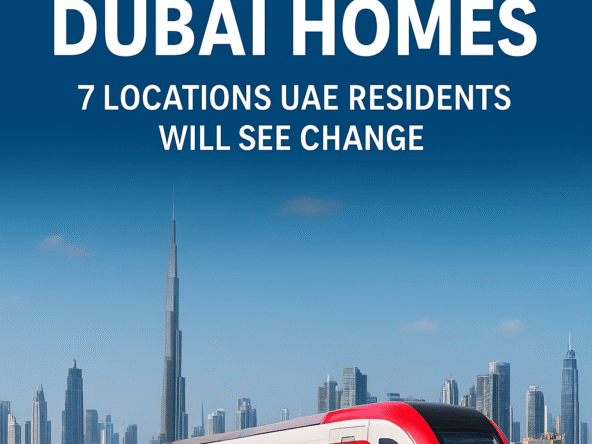Dubai New Mega Airport “A Game-Changer with 400 Gates”
Dubai has always been synonymous with ambition, innovation, and breaking global records. From the world’s tallest building, the Burj Khalifa, to the largest shopping destination, Dubai Mall, the emirate has constantly set new benchmarks. Now, Dubai is gearing up to rewrite aviation history with its new mega airport—Al Maktoum International (DWC)—a futuristic hub that will feature an astounding 400 gates, making it the largest and most advanced airport in the world once completed.
This mega project isn’t just about size; it represents Dubai’s long-term vision to remain the undisputed global aviation capital, supporting its position as a crossroads between East and West.
The Vision Behind the Mega Airport
Dubai’s success has always been tied to its role as a global connector. Dubai International Airport (DXB) is already one of the busiest airports in the world for international passengers. In 2024 alone, DXB handled over 87 million travelers, surpassing pre-pandemic levels. But with growing passenger traffic and the UAE’s bold economic ambitions, expansion became inevitable.
The new Al Maktoum International Airport, located in Dubai South, is designed to handle up to 260 million passengers annually—nearly triple the current capacity of DXB. The project aligns with Dubai Economic Agenda D33, which aims to double the emirate’s economy in the next decade and establish it as one of the world’s top three cities for business and tourism.
Key Features of the Mega Airport
400 Aircraft Gates
The most eye-catching feature is the sheer number of gates—400 in total. This will allow multiple superjumbo aircraft, such as the Airbus A380 and Boeing 777X, to dock simultaneously, eliminating bottlenecks and enabling smoother operations.
Capacity for 260 Million Passengers
The airport will be capable of handling 260 million passengers every year. This dwarfs any existing airport globally and positions Dubai as the ultimate hub for international travel.
State-of-the-Art Cargo Operations
The facility will be equally advanced for cargo, with the ability to process 12 million tonnes annually. This will make it a critical hub for global trade and logistics, connecting Asia, Africa, and Europe seamlessly.
Sustainability and Smart Technology
Dubai has pledged that the airport will integrate green aviation initiatives, from solar-powered facilities to sustainable building materials. Artificial Intelligence (AI), biometric check-ins, and smart baggage handling will ensure faster, more secure passenger processing.
Integrated Aerotropolis
Surrounding the airport will be Dubai South, a master-planned city designed to support aviation, logistics, commerce, and residential living. This “airport city” will offer hotels, business parks, free zones, and residential communities, making it a hub for both travelers and residents.
Why Build a 400-Gate Airport?
Some may ask: Why does Dubai need such a massive airport? The answer lies in Dubai’s unique position in global aviation and trade.
Strategic Location: Dubai sits within an eight-hour flight of two-thirds of the world’s population, making it the perfect transit hub.
Growing Tourism: The UAE welcomed over 17 million tourists in 2023, and the government aims to double this by 2030. A bigger airport is essential to manage this influx.
Economic Growth: Aviation already contributes over 27% of Dubai’s GDP. With the new airport, this figure is expected to rise significantly.
Capacity Limitations at DXB: Dubai International Airport, despite expansions, cannot handle unlimited growth. Al Maktoum International provides the space and scalability needed for the next 50 years.
Impact on Dubai’s Economy and Real Estate
The mega airport is not just an aviation project; it’s an economic catalyst.
Job Creation: Construction and operations will create hundreds of thousands of jobs, from engineers and pilots to hospitality staff and logistics experts.
Real Estate Boom: The area around Dubai South is already witnessing a surge in property demand. Communities near the airport, such as Emaar South and DAMAC Lagoons, are becoming prime hotspots for investors.
Business Opportunities: Free zones and logistics hubs connected to the airport will attract international companies, boosting Dubai’s position as a global business center.
Tourism Growth: With smoother travel experiences and direct flights to more destinations, Dubai is set to strengthen its reputation as a leading tourist destination.
A Comparison with Global Airports
When complete, Al Maktoum International will make other mega airports look modest in scale:
Atlanta (ATL): Currently the world’s busiest airport with around 110 million passengers yearly. DWC aims for 260 million.
Beijing Daxing: A marvel of modern architecture handling 72 million passengers annually. Dubai’s airport capacity will more than triple this.
Heathrow (LHR): London’s main hub processes around 80 million passengers per year, but space constraints prevent significant expansion.
With 400 gates, Dubai’s new airport will outpace all these facilities, cementing its role as the aviation leader.
Timeline and Development
Construction of Al Maktoum International began over a decade ago, with partial operations already underway. Cargo services and limited passenger flights currently operate from DWC, but the full vision is unfolding in phases:
Phase 1 (2025–2030): Expansion of terminals, runways, and logistics facilities.
Phase 2 (2030–2040): Full-scale operations with all 400 gates operational.
Beyond 2040: Continuous upgrades as technology and aviation demands evolve.
Challenges and Considerations
While the mega airport is ambitious, it comes with challenges:
Environmental Concerns: Large-scale aviation expansion must balance sustainability with growth.
Competition: Neighboring hubs like Doha and Istanbul are also expanding aggressively.
Capital Investment: The project requires billions in funding, though Dubai has a strong track record of delivering mega projects.
The Future of Travel Through Dubai
Imagine a future where you can arrive at the world’s largest airport, breeze through AI-powered immigration, shop at luxury outlets, relax in futuristic lounges, and board your aircraft at one of 400 gates without delays. This is the vision Dubai is bringing to life.
The new mega airport will not just be an infrastructure project—it will redefine how the world experiences air travel. For passengers, it means speed, convenience, and global connectivity. For businesses, it means opportunity. For Dubai, it means securing its legacy as the beating heart of global aviation for decades to come.
Conclusion
Dubai’s upcoming mega airport with 400 gates is more than a record-breaking project—it is a symbol of the emirate’s ambition, resilience, and global leadership. By creating the largest aviation hub in the world, Dubai is investing in the future of travel, trade, and tourism.
As the project unfolds, it will bring profound economic benefits, reshape real estate landscapes, and inspire future generations. Just as the Burj Khalifa redefined skylines, the new Al Maktoum International Airport will redefine the skies.
The message is clear: The future of global aviation takes off from Dubai
Dubai New Mega Airport “A Game-Changer with 400 Gates”





